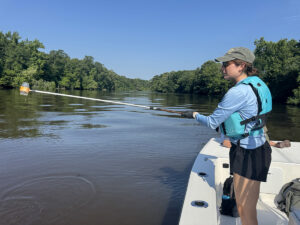News
Animal Facility Waste Lagoons and Wastewater Spills; HF Lee Coal Ash Ponds Flooded: Flood Waters Pose Health Risk
Posted on September 18th, 2018
A Murphy-Brown-owned swine facility West of Trenton, NC, where the lagoon has been over topped by flood waters.
Our staff and other media outlets have documented a number of hog waste lagoons and poultry barns flooded along the Trent River near Trenton in Jones County. In the Cape Fear River Basin, which includes Duplin County, many more waste pits have flooded and some breached, spilling hog waste and sludge into the Cape Fear River and streams.
Sanderson Farms released a statement Monday noting that 60 chicken houses and four breeding facilities were flooded, resulting in 1.7 million bird deaths across the region.
Old, unlined coal ash ponds at Duke Energy’s HF Lee facility in Goldsboro are currently flooded. This is the area that released large amounts of coal ash after Hurricane Matthew, discovered by your Upper Neuse Riverkeeper. It is possible that we may see a similar discharge to the Neuse River in the near future.
In addition, Johnston County has reported a 109,000 gallon sewer spill over the weekend. The City of Greenville reported spills close to 10,000 gallons due to the flooding. New Bern’s wastewater treatment plant continues to operate, put the pump stations across town failed. In large storm events, it is highly likely that numerous sewer spills occurred in many communities. Information may still come in the coming days to confirm this. Major wastewater spills occurred in Wilmington and Jacksonville.
This is a good reminder of why it is extremely important to avoid flood waters and avoid primary contact with our rivers and streams for the next week or more. Not only is it dangerous, due to high flows, but our waterways may be contaminated. Pollution from these sources can contain high levels of bacteria and waterborne viruses, toxic heavy metals, and chemicals that are harmful to humans and pets. It is also important to use extreme caution when boating, and wear a properly fitted personal flotation device at all times. High waters continue to dislodge and carry trash, logs, and other debris downriver and much of this debris can float just below the surface and cause damage to watercraft and/or injury to boaters.
What will Happen to the Rivers in the Coming Weeks?
Taking lessons learned from previous hurricanes, like Matthew and Floyd, we can take an educated guess as to what will happen to our rivers, estuaries and sounds in the coming weeks.
- It is highly likely flooded rivers and regions will experience fish kills. Flooding flushes in a lot of material that will break down in the river, causing oxygen depletion in the coming days, weeks.
- Increased ratio of freshwater to saltwater – Salinity in Pamlico Sound decreased by 70% following Floyd. Increased freshwater input causes layers of fresh and salt water to form, trapping salt water below and reducing oxygen levels.
- Low dissolved oxygen levels – Dissolved oxygen is necessary to all forms of aquatic life. Following Fran it took two months for oxygen levels to return to normal. Current data suggests oxygen levels are very low, but no fish kills have been reported.
- Increased dissolved organic carbon (DOC) – DOC contributes to the growth of microorganisms, and oxygen depletion.
- Decreased residency time – The time a molecule of water spends traversing Pamlico Sound was reduced from about 12 months to two months following Floyd. Pamlico Sound’s long residency time makes it particularly sensitive to nutrient loading.
- Increased nutrient loading – Nutrients like nitrogen and phosphorus contribute to algae blooms and fish kills in estuarine systems. Hurricane Fran doubled the annual nutrient loading into Pamlico Sound and was followed by massive fish kills.
Related News

Neuse fish kill expected to extend beyond holiday weekend
July 3rd 2025

Swim Guide fails prompt Maple Cypress investigation
July 3rd 2025

Riverkeeper, town partners root out source of Smithfield sediment pollution
July 3rd 2025

Trash trap No. 12 approved for Smithfield
July 3rd 2025

Sunset River Paddle fundraiser boosts Water Quality Fund
July 3rd 2025

Riverkeepers host quarterly Water Watch meeting
July 3rd 2025

Public hearing will determine the fate of many NC wetlands
June 26th 2025

Clayton gets first official trash-trap cleanout
June 25th 2025


